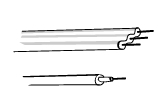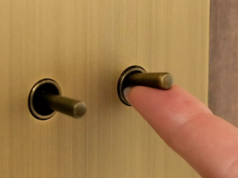
Find out about the different sorts of cable that are used to install electrics throughout your home, and why they’re used.
Is cabling important?
In short, absolutely! It’s the one part of an electrical installation that you don’t see, but out of sight shouldn’t mean that it’s completely out of mind. The house wiring has to be able to withstand high temperatures – and of course it heats up in part because of the electrical current flowing through it. This heat is generated due to what electricians call ‘I-squared R loss’ – but another way is to picture it as a kind of ‘frictional resistance’ to the electrical current it’s carrying. If you live in a particularly hot area and your electrical installation has a large number of power points that are likely to be in use for extended times, a special type of cable called XLPE insulated should be used. XLPE stands for ‘cross linked polyethylene’.

Flat and round cable
For general house wiring, PVC insulated cable is what’s normally used. The cable comes in flat and round styles. The round cables are single conductors, and are likely to be used for heavy current loads like split system multi-zone air conditioners. The flat cables usually have three conductors side by side; an active, neutral, and earth wire. These three are needed for just about everything you plug in, other than double insulated tools. It is also needed for transformers for low voltage halogen lighting and for lighting with exposed luminaires.
Current ratings for cables
The capabilities of wiring are determined in part by the cross sectional area of the copper conductors. It’s a critical measurement, and it defines the cable’s ability to carry electrical current. For a three-conductor, flat cable with 1 square millimetre copper, 16 amps is the capacity if the cable is exposed in open air. If it is covered in roof insulation, the capacity is halved to 6 amps due to the heat. To put things in proportion, a power point is normally assumed to carry up to 10 amps of electrical current when working out the circuits and protection to be put in place.
Voltage rating
Voltage ratings are the ratings used to determine how much voltage a cable can safely use. Most circuits in a domestic installation are 230 or 240 volt, single phase, although domestic cables are normally rated for much higher voltages (around 600 volts or more). The difference is the added insulation on the cable – a cable rated at 240V would be likely to be too easily damaged.
Smart wiring or structured cabling
Smart Wiring (also known as ‘structured cabling’) refers to a popular system of wiring homes, which carries not only power cables but also the necessary cabling for high speed data and multimedia communications, including Cat 6 network cables. The advantage of installing Smart Wiring throughout your home is that even if you don’t intend to install high demand multimedia or home automation components in your home immediately, the option will always be there to do so very easily at a later date. Although Smart Wiring can be retrofitted into homes, the scale of the task means that the ideal time to install Smart Wiring is during the ‘roughing in’ stage, when the power cabling is being put in.





